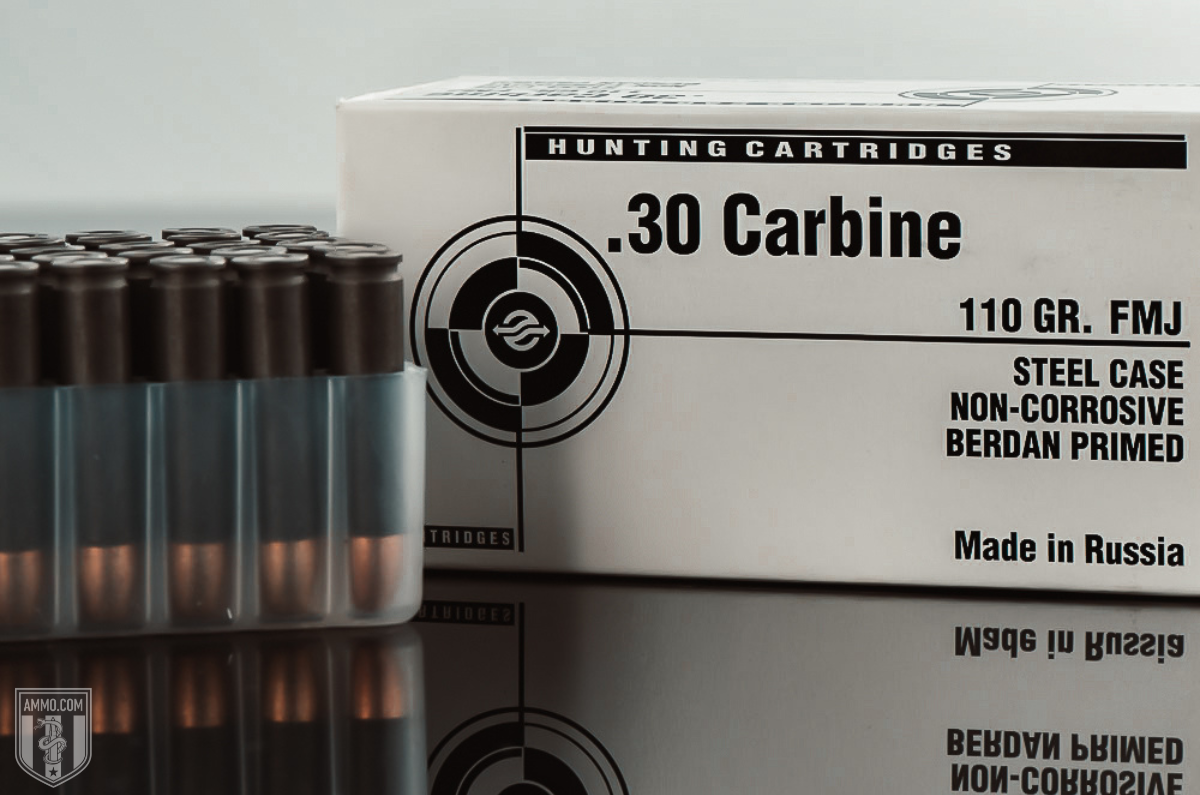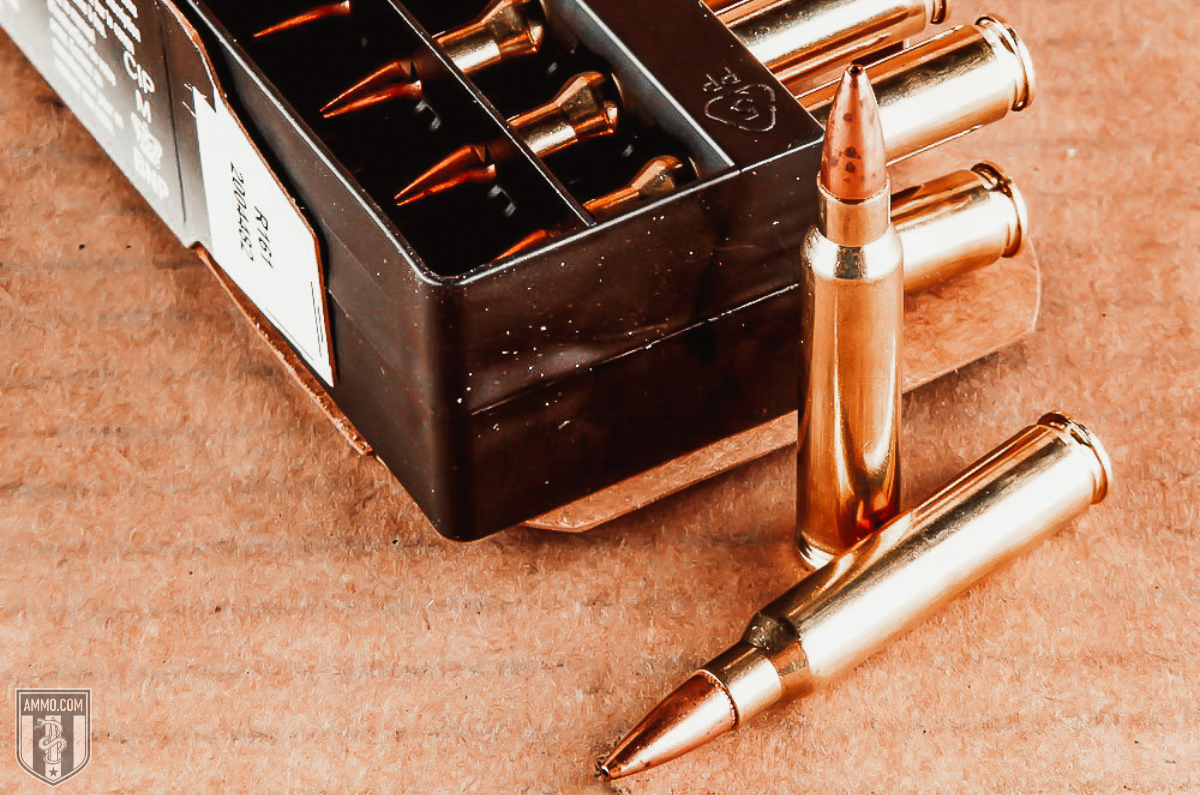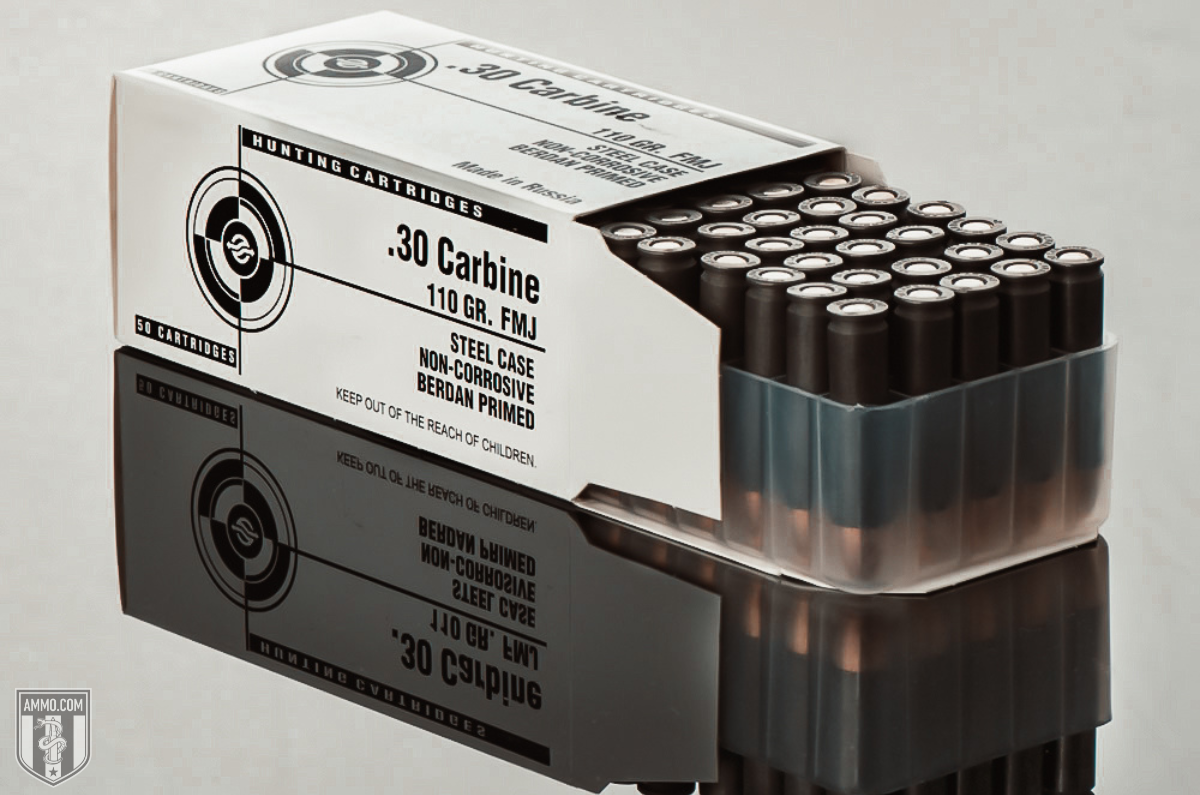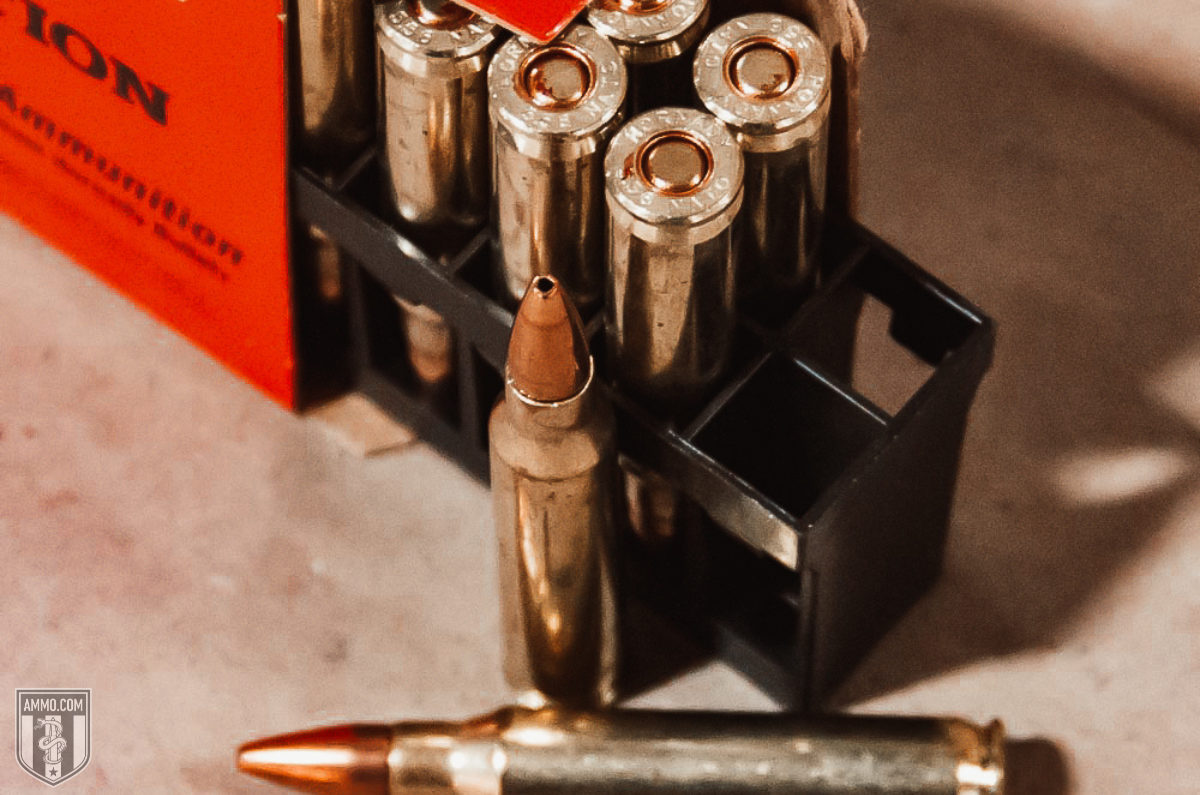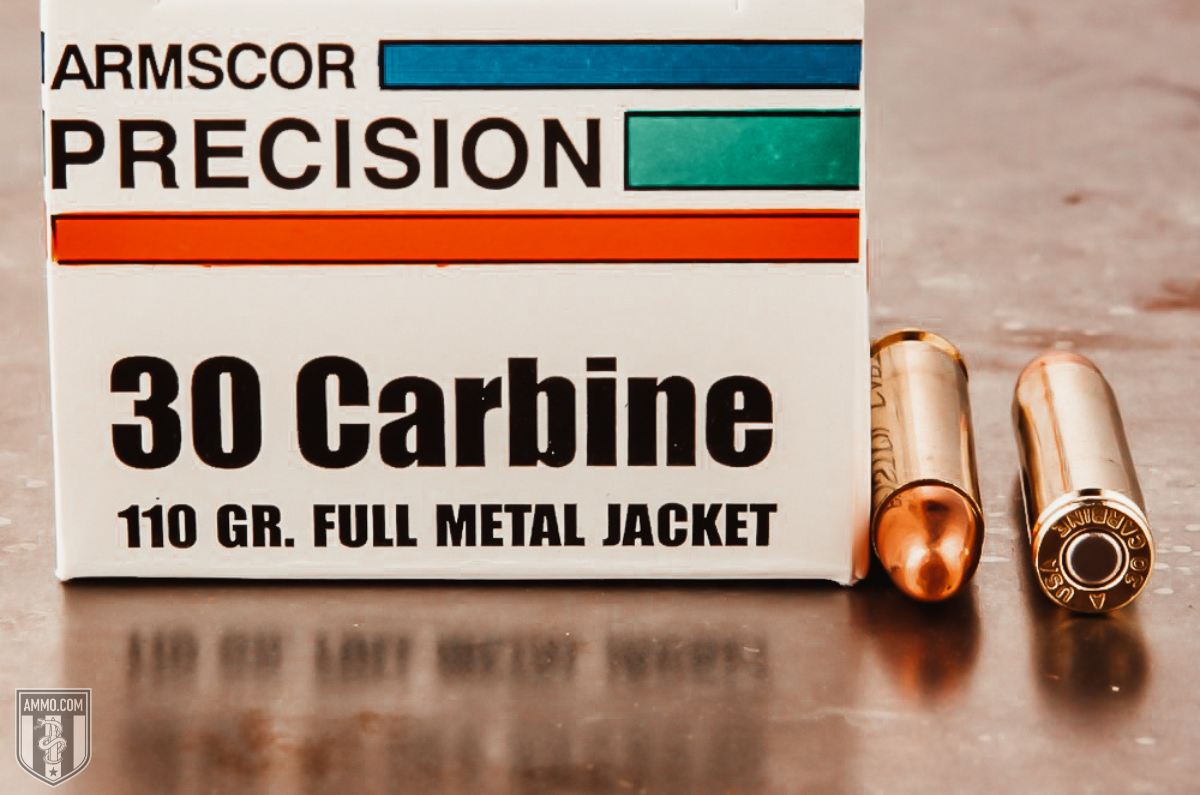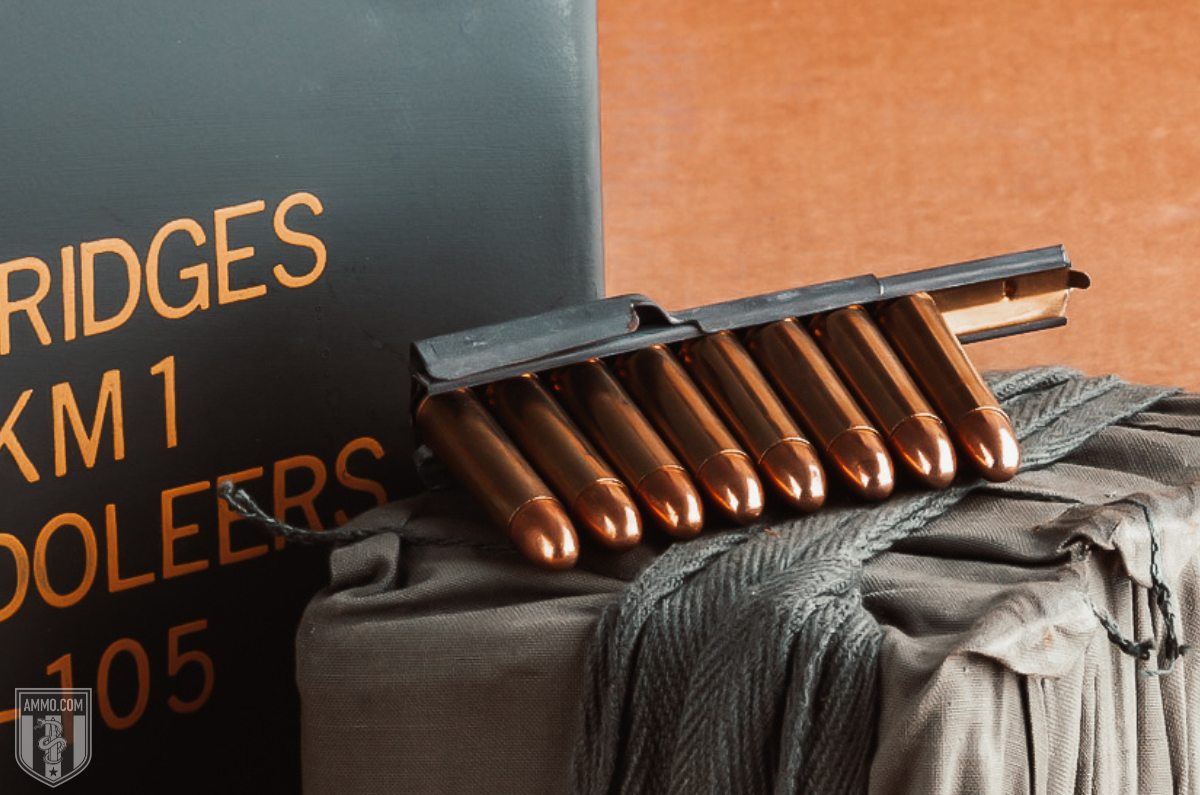30 Carbine vs 5.56: Beloved Military Rounds

Two battle-tested opponents, the 30 Carbine vs 5.56, duke it out to determine if the 5.56 is worth all the hype or if the more experienced 30 Carbine should still be used in certain instances.
As you continue reading, we'll compare each caliber in ten categories that matter most to shooters and determine a winner.
If you can't wait, the 5.56 won 7/10 sections, easily making it the better option in most instances.
Now let's find out in which areas the 30 Carbine is better than the 5.56!
30 Carbine vs 5.56
The 5.56 NATO was essentially created to replace the 30 Carbine. Though they were designed for similar purposes, the rounds are very different in appearance and cartridge specs.
Below you'll see the specs of the two rounds and be able to compare them to see which one catches your attention the most.
Cartridge Specs
As you first glance at these rounds, you'll notice the straight-walled cartridge of the 30 Carbine and the bottleneck cartridge of the 5.56.
The 32 Winchester Self-Loading Cartridge is the parent case for the 30 Carbine. The 30 Carbine was necked down to accept a 0.308" diameter, 110-grain full metal jacket (FMJ) bullet.
In contrast, the 223 Rem is the parent case for the 5.56, and only slight modifications were made to the round. So minimal, in fact, 223 Remington ammo can safely be fired in guns chambered for 5.56, which is why many assume they're the same.
Check out this article to dive deeper into the 223 vs 5.56 debate.
The bullet diameter of the 5.56mm is 0.224 in, and the neck diameter is 0.253 in, the same as the 223.
The 30 Carbine has a neck diameter of 0.336 in and a base diameter of 0.3548 in, which is smaller than the 5.56 base diameter of 0.377 in.
The case length of the 30 Carbine is 1.29 in, while the 5.56NATO case length is 1.760 in.
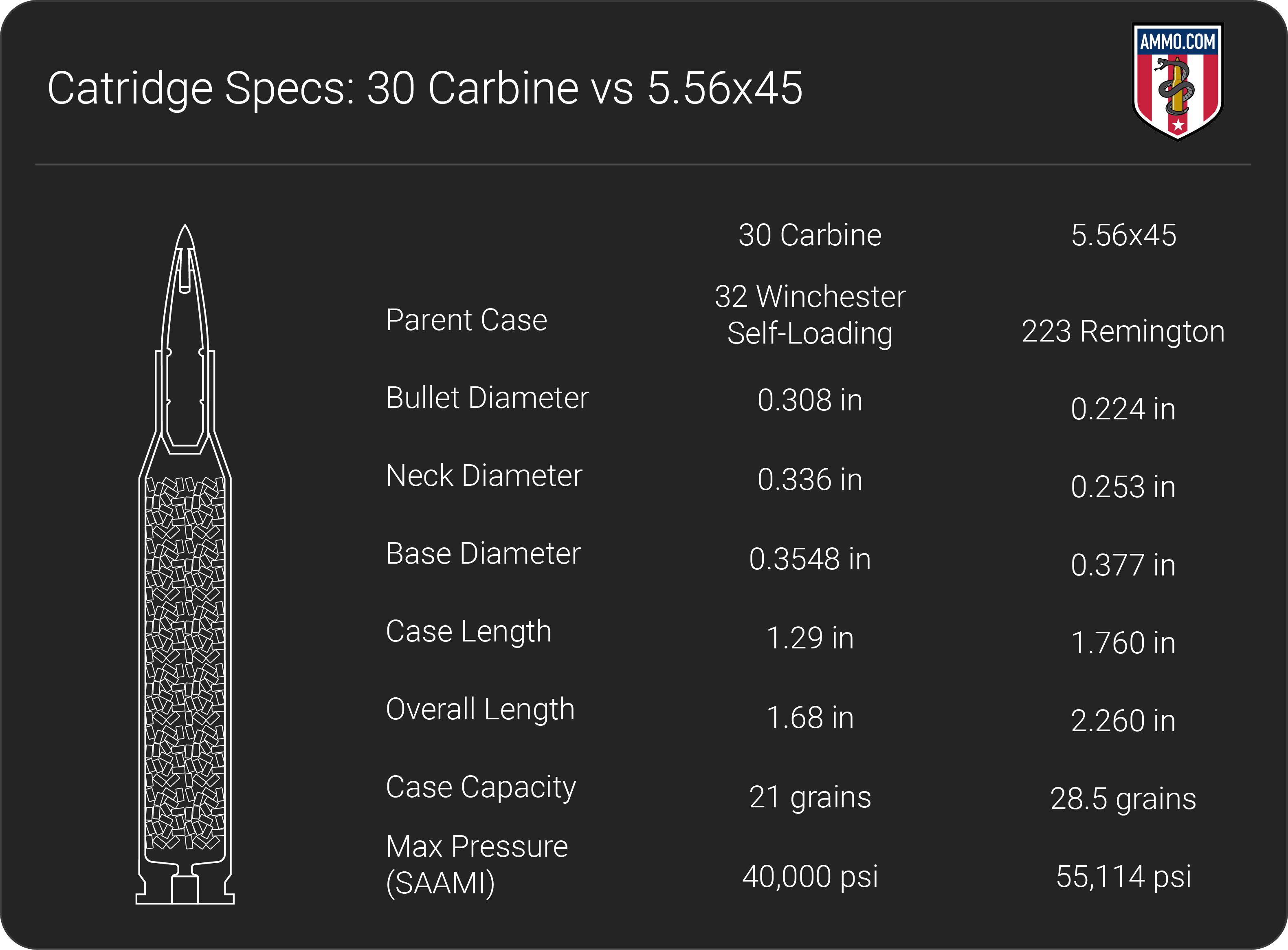
The 30 Carbine has a shorter overall length of 1.68". The 5.56 is 2.260" in length overall.
The straight wall case of the 30 Carbine has a capacity of 21-grains, while the bottleneck case of the 5.56 has a case capacity of 28.5gr.
The 5.56 cartridge was designed for a maximum pressure (SAAMI) of 55,114 psi. The 30 Carbine cartridge was designed for a max pressure of 40,000 pounds per square inch.
Now that we understand the size differences between these two calibers let's see how that translates into real-world situations.
Recoil: 5.56 vs 30 Carbine
I always include recoil in the discussion because when a shooter is introduced to a new caliber, the first question they often ask is, "how hard does it kick?".
I think this is a great question, as I often ask it myself when trying a new gun, so I'll answer it as best I can without you testing it for yourself.
Knowing how much recoil to expect will help you as the shooter flinch less and be more accurate with the round.
It's also important to note that the lower the recoil, the more accurate the average shooting enthusiast is with the round.
Now, felt recoil is affected by many things, such as gun weight, bullet weight, and the shooter, so we shall proceed with all things considered as equally as possible.
Neither round has much recoil as both calibers are well under 10lbs of free recoil.
A 30 Carbine M1 110gr FMJ at 1,990 fps military load has 5 ft-lbs of free recoil, while a 5.56 M193 55gr FMJ at 3,200 fps military load has 4.25 ft-lbs of free recoil.
It's unlikely that if you were to shoot these rounds side-by-side, you'd be able to tell the difference in recoil.
However, the 5.56 NATO has a slight advantage in this section and takes an early lead.
Trajectory
The trajectory is the bullet's path to the target, which is typically an arch (besides at close distances) due to the effects of gravity. It's measured in bullet drop, or the amount of inches the bullet falls at that distance.
A flat trajectory is preferred because the shooter will not have to make significant changes as the distance increases, leading to better accuracy.
A lighter, faster-traveling bullet tends to have a flatter trajectory because it can resist gravity for longer than a heavier, slower bullet.
A 5.56NATO Winchester 55 gr FMJ boat tail M193-clone zeroed in at 100 yards will have a bullet drop of -2.8" at 200yds and -52.8" at 500yds. As we increase the distance past 500 yards, the fall becomes exponentially more.
The 30 Carbine M1 110gr FMJ round nose military load with a 100-yard-zero has a bullet drop of -12.9" at 200yds and -226.4" at 500yds. This round was designed for close-quarters combat.
The winner is easily the 5.56mm, as its lighter, faster bullets offer shooters a much flatter trajectory.
Accuracy: 30 Carbine vs 5.56 NATO
The accuracy of a round is determined by many factors, such as the shooter, gun, optics, and physics of the bullet.
The two significant factors I'll use in this article are the recoil and trajectory. A low recoil round with a flat trajectory is much easier to be accurate with than a heavy recoil round with lots of bullet drop.
Though the 5.56x45mm has slightly less recoil than the 30 Carbine, the flat trajectory is where the accuracy can be seen, especially at distances within 750 yards.
The 30 Carbine is an accurate round within 500 yards. Still, the bullet drop significantly increases around 400yds, making it more challenging to be accurate with it, even at closer ranges such as 200-300yds.
The winner of the accuracy category is the 5.56 because it has slightly less recoil but a much flatter trajectory.
Ballistic Coefficient
The ballistic coefficient (BC) measures the aerodynamics of a bullet and how well it will fight wind drift.
A higher BC means the bullet is more aerodynamic and will perform better than a lower BC bullet.
The Winchester M193 5.56 factory ammo has a BC of 0.255; this isn't great if you compare it to a long-distance round such as the 6.5 Creedmoor, which has a BC of 0.585.
However, the 110gr FMJ 30 Carbine has a ballistic coefficient of 0.166 because the bullets are short and fat, which doesn't make for good aerodynamics.
The 5.56mm NATO continues its dominance in the ballistic coefficient section thanks to its Spitzer boat tail bullet design, which is sleeker, resists wind drift, and air resistance more efficiently than the 30 Carbine.
Stopping Power: 5.56 NATO vs 30 Carbine
Stopping power is a hotly debated topic. On one side, people claim it doesn't matter because it only takes one well-placed shot to eliminate a threat.
While this is true, in a high-pressure situation, a well-placed shot isn't always possible.
On the other hand, you have the people who claim bigger is always better.
While a more significant hole will stop the threat quicker, it's also tougher to be accurate with large caliber guns because of the increased recoil.
So I settle in the middle, where stopping power is essential, but you need to be comfortable and accurate with your chosen round.
There are different ways to determine stopping power.
One is by the bullet's sectional density, and the other is by how big of a hole it leaves in the target.
The sectional density (SD) is a way to evaluate how well a bullet penetrates based on its external dimensions, design, and weight.
The 110gr 30 Carbine FMJ has an SD of 0.166, while the 5.56x45 M193 load has an SD of 0.155.
The size and type of bullet determine the size of the hole left in the target. It's clear a larger bullet leaves a bigger hole, but the same size FMJ bullet and hollow point (HP) bullet will leave two different-sized holes, with the HP bullet leaving a larger hole.
Both calibers offer hollow-point bullets, so the advantage falls back to the 30 Carbine because it's a larger bullet.
The 30 Carbine wins its first section; let's see if it can keep the momentum up and catch the 5.56.
Hunting
These rounds were initially designed for the military, but civilians have used variations for hunting for many decades.
The 5.56 is one of North America's most popular varmint hunting cartridges. A 5.56x45mm NATO long gun with a decent scope makes for many groundhog or coyote nightmares because it has low recoil and a flat trajectory.
The 30 Carbine also makes a decent varmint cartridge for short-range shots because the trajectory starts to look like a rainbow at longer distances.
Choosing to use these calibers to hunt medium-sized game such as whitetail deer or pronghorn is frowned upon by many because they either lack the 1,000 ft-lbs of kinetic energy typically cited as the minimum to ethically harvest whitetail as is the case for the 30 Carbine or the bullets are too small as with the 5.56.
One should also note that many states prohibit using 0.224" diameter bullets for deer hunting, so if you live in one of these states, you wouldn't be allowed to deer hunt with a 5.56.
The 5.56 NATO is slightly advantageous when hunting because it can reach varmints at longer ranges.
Home Defense: 30 Carbine vs 5.56mm
I'm not a fan of using a rifle as a home defense weapon because of over-penetration. While these cartridges are designed for carbines, they still tend to over-penetrate as a rifle cartridge will.
However, when we disregard the over-penetration problem, each caliber has a distinct advantage over the other regarding self-defense at close range.
The 5.56 is chambered in the AR-15 platform, designed with urban combat in mind, so it has light recoil and 30-round magazines, but it's more likely to go through multiple walls. If you're considering this round for self-defense, be sure to choose the best 5.56 ammo for self defense to maximize safety and effectiveness.
The 30 Carbine is a harder-hitting round, thanks to the larger bullet, and there are many semi-auto offerings with a decent round capacity. It's also less likely to penetrate walls and endanger your family and neighbors.
Hornady manufactures 30 Carbine Critical defense ammo, one of the most trusted self-defense rounds on the market.
This section is a draw because both rounds have advantages and disadvantages for home defense. It ultimately comes down to your preferences.
Ammo Cost & Availability
One should consider the price of ammo because it's a multiple-time purchase. You must keep buying ammo if you want to continue shooting your firearm.
It's easy to blow through your multiple boxes of ammo, and your paycheck for that matter, when shooting semi-automatic guns, so paying attention to the price per round is the best way to understand how much it will cost.
Inexpensive 5.56 ammo, like Wolf Gold 55-grain FMJ, will cost around $0.73 per round, while Barnes Precision Match 85-grain OTM 5.56x45 Ammo costs $1.45 each time you pull the trigger.
You can always save money by buying bulk 5.56 ammo and getting a good deal on trusted brands like Winchester, Hornady, and Federal.
Because this round is one of the most popular in the U.S., it's usually readily available, except in times of high demand, such as when the government threatens to take away "assault weapons."
For plinking 30 Carbine ammo, expect to pay $0.82 or more per round. If you need self-defense or hunting ammo, the price goes up to $1.50-2.25 per round.
Because the 30 Carbine has waned in popularity, the ammo is much more difficult to find than 5.56 ammo.
30 Carbine ammunition is more expensive and less available than 5.56 ammunition. The 5.56x45 easily wins this section.
Rifle Cost & Availability: 5.56mm vs 30 Carbine
As you know, gun prices vary greatly; an AR-15 chambered in 5.56 can cost anywhere from $500-$2,000. The availability of these guns often depends on how actively the government is trying to pass legislation against the 2nd Amendment.
The price of 30 Carbine guns varies less, as they are naturally more expensive. An Auto-Ordnance Thompson M1 Carbine Vengeance Rifle will cost $1,000 if you can find it, and that's a cheap firearm chambered in 30 Carbine.
An Inland Manufacturing M1 Carbine Paratroopers Rifle ups the ante a little at $1,250, but that's nothing compared to the NOS 47548 M48 Mountain Carbon 30 Nosler, which costs $2,870.
Guns chambered in 30 Carbine are becoming challenging to find, which usually drives up the price even more.
The 5.56x45mm NATO is the better choice if you want a reasonably priced firearm.
Reloading
There are a few advantages reloading gives serious shooters. First, it's an excellent way to save money, and second, it gives shooters ultimate control over the controllable variables.
In the long run, it's cheaper to handload centerfire cartridges because you can reuse them, and when you buy the supplies in bulk, you save more money. The problem is having the money upfront.
Reloading allows you to dial in the perfect amount of powder for the bullet and gun you're using to get better consistency and accuracy out of the rounds compared to factory ammo.
This section is a tie because both rounds offer the opportunity to reload.
5.56x45mm Ballistics vs 30 Carbine Ballistics
Note: This information comes from the manufacturer and is for informational purposes only. The actual ballistics obtained with your firearm can vary considerably from the advertised ballistics. Also, ballistics can vary from lot to lot with the same brand and type load.
30 Carbine Ballistics
A 110gr bullet can be expected to travel at 1,990 fps with an energy of 967 ft-lbs force when shot from the M1 Carbine with an 18-inch barrel comparable to a .357 Magnum bullet fired from a carbine with an 18-inch barrel.
| 30 Carbine Bullet WEIGHT | Muzzle VELOCITY (fps) | Muzzle ENERGY (ft. lbs.) | TRAJECTORY (in.) | |||||||||||
|---|---|---|---|---|---|---|---|---|---|---|---|---|---|---|
| Muzzle | 100 yds. | 200 yds. | 300 yds. | 400 yds. | Muzzle | 100 yds. | 200 yds. | 300 yds. | 400 yds. | 100 yds. | 200 yds. | 300 yds. | 400 yds. | |
| 110 Grain | 1990 | 1567 | 1236 | 1035 | 923 | 977 | 600 | 373 | 262 | 208 | 0 | -13.5 | 0 | 0 |
| 110 Grain | 2000 | 1601 | 1279 | 1067 | n/a | 977 | 626 | 399 | 278 | n/a | 0 | -12.9 | -47.2 | n/a |
5.56 Ballistics
| 5.56x45mm Bullet WEIGHT | Muzzle VELOCITY (fps) | Muzzle ENERGY (ft. lbs.) | TRAJECTORY (in.) | |||||||||||
|---|---|---|---|---|---|---|---|---|---|---|---|---|---|---|
| Muzzle | 100 yds. | 200 yds. | 300 yds. | 400 yds. | Muzzle | 100 yds. | 200 yds. | 300 yds. | 400 yds. | 100 yds. | 200 yds. | 300 yds. | 400 yds. | |
| 55 Grain NATO | 3130 | 2740 | 2382 | 2051 | 1750 | 1196 | 917 | 693 | 514 | 372 | 1.1 | 0 | -7.3 | -23 |
| 75 Grain NATO | 2910 | 2676 | 2543 | 2242 | 2041 | 1410 | 1192 | 1002 | 837 | 693 | 1.2 | 0 | -7 | -21 |
30 Carbine History
In 1938 the U.S. military received reports from the field that the M1 Garand rifle, the standard long gun of the U.S. Armed Forces, was too large and heavy and got in the way of soldiers, slowing them down.
The U.S. Army needed a carbine, something that would be a better battle rifle. It needed more range and power than the M1911A1, the standard .45 ACP handgun, and lighter than the M1 Garand.
This need became the "light rifle project."
In June of 1940, then US Secretary of War Henry Stimson ordered the development of a light weight rifle. The Carbine needed to weigh five pounds or less (about half the weight of the M1 Garand rifle and Thompson submachine gun) and fire a bullet with a diameter greater than .27 caliber. At 300 yards, the bullet should remain effective and have a mid-range trajectory ordinate of 18 inches or less.
Winchester got the job of creating the ammunition.
Edwin Pugsley, a designer at Winchester, took the self-loading .32 Winchester cartridge and used it as the base for the new rifle round. He used a round nose .308 caliber bullet with the rimless case.
At its first production, it propelled a 120-grain bullet at a muzzle velocity of 2,000 fps. The first 100,000 rounds were stamped ".30 SL" for self-loading.
During World War II, the M1 Carbine wooden stock was issued with a 15-round magazine to infantry, machine gun, artillery, tank crews, paratroopers, and communication soldiers.
The U.S. military used the M1 and M2 Carbine from the early 1940s through the 1970s. This included wars such as:
- WWII
- Korean War
- First Indochina War
- Vietnam War
The U.S. military used these carbines until replacing them with the M16 and its variants in the 1970s.
The round remains popular amongst collectors, hunters, sports shooters, and re-enactors.
5.56 History
In 1957, the development of the 223 Rem rifle round began, and in 1962 the final design was submitted by Remington Arms to the Sporting Arms and Ammunition Manufacturers' Institute.
The 223 Remington cartridge used the 222 Remington as a parent cartridge and, once it was approved, received the name M193 from the military.
The M193 cartridge served the U.S. Army through Vietnam. However, FN Herstal changed the game several years later.
In 1980, the Belgian firearms and cartridge manufacturer submitted their designs for the SS109 5.56x45mm cartridge to NATO for approval. The new 5.56 had identical external dimensions to the 223 Rem; however, the NATO cartridge could handle higher maximum pressure.
Through the years, the round has been tweaked to increase its terminal performance, and today is the most popular caliber among shooters all over the U.S.
Parting Shots
It's easy to see why the U.S. Military decided to replace the 30 Carbine with the 5.56 NATO.
When we pitted the 30 Carbine vs 5.56, the 5.56 won 7/10 categories and tied in two, thanks to its low recoil and high accuracy capabilities.
The one instance the 30 Carbine prevailed over the 5.56 was in stopping power, so if you need a little more stopping power at close ranges, the 30 Carbine is the round you want.
Ammo Comparisons
- .308 vs 5.56
- 6.5 Creedmoor vs .308
- .300 Blackout vs .308
- .300 Win Mag vs .308
- .243 vs .308
- .308 vs .30-06
- 7mm-08 vs .308
- .270 vs .308
- 7.62x39 vs .308
- .223 vs .308
- .338 Lapua vs .308
- .380 ACP vs 9mm
- .223 vs 5.56
- .300 Blackout vs 5.56
- 9mm vs 45 ACP
- 9mm vs 40 S&W
- .357 SIG vs 9mm
- 10mm vs 9mm
- 9mm vs 9mm Luger
- .243 vs .270
- .300 Win Mag vs .30-06
- .270 vs .30-06
- .40 vs .45
- 38 Special vs 357
- 9mm vs 40 vs 45
- 5.56 vs 7.62x39
- 338 Lapua vs .30-06
- .30-30 vs .30-06
- 300 PRC vs 338 Lapua
- .30-06 vs 7mm
- 300 Win Mag vs 338 Lapua
- 300 PRC vs 300 Win Mag
- 300 WSM vs 300 Win Mag
- 338 Win Mag vs 338 Lapua
- 12 Gauge vs 20 Gauge
- 10mm vs 357 Mag
- .30-30 vs 7.62x39
- 224 Valkyrie vs 22-250
- 17 HMR vs 22 Mag
- 7.62x39 vs .300 Blackout
- 45 ACP vs 45 Auto
- 45-70 vs 30-30
- 300 Blackout vs 223
- 357 Magnum vs 9mm
- 350 Legend vs 300 Blackout
- 224 Valkyrie vs 223
- 45 ACP vs 38 Super
- 6.5 Grendel vs .308
- 17 HMR vs 22 LR
- 10 Gauge vs 12 Gauge
- 22-250 vs 223
- 45 Colt vs 45 ACP
- 350 Legend vs 30-30
- 5.7x28 vs 223
- 5.7 vs 9mm
- 5.56 vs 5.7
- 22 vs 9mm
- Buckshot vs Birdshot
- 450 Bushmaster vs 308
- 450 Bushmaster vs 223
- Buckshot vs Slug
- 6.5 Grendel vs 5.56 vs 223
- 6mm ARC vs 6.5 Grendel
- 44 vs 45
- 458 SOCOM vs 5.56
- 357 vs 44
- 32 ACP vs 380
- 300 Win Mag vs 338 Win Mag vs 338 Lapua Mag
- 450 Bushmaster vs 458 SOCOM vs 50 Beowulf
- 6mm Creedmoor vs 6.5 Creedmoor
- TMJ vs FMJ
- 44 Special Vs 44 Magnum
- 45 90 vs 45 70
- 6.8 Western vs 6.8 SPC
- 50 Beowulf vs 50 BMG
- 26 Nosler vs 6.5 PRC
- 28 Gauge vs 410
- 6.8 SPC vs 5.56
- 6.8 SPC vs 6.5 Grendel
- 6.8 Western vs 7mm Rem Mag vs .28 Nosler
- 6.8 Western vs 6.5 Creedmoor
- 22 Hornet vs 223
- 6.8 Western vs 6.5 PRC
- .410 vs 12 Gauge
- .410 vs 20 Gauge
- 22 LR vs 22 Mag
- 6mm ARC vs 243
- 7mm-08 vs 270
- 243 vs 6.5 Creedmoor
- Nickel vs Brass Casing
- 204 Ruger vs 223
- 50 Beowulf vs 5.56
- 260 Remington vs 6.5 Creedmoor
- 6mm Remington vs 243
- 28 Nosler vs 300 PRC
- 50 Beowulf vs 50 AE
- 22 Nosler vs 22-250
- 450 Marlin vs 45-70
- 300 Win Mag vs 300 Norma
- 458 SOCOM vs 300 Blackout
- 38-55 vs 45-70
- 22 Hornet vs 22 LR
- 300 Norma vs 338 Lapua
- 338 Lapua vs 50 BMG
- 28 Nosler vs 300 Win Mag
- 28 Nosler vs 6.5 Creedmoor
- 204 vs 22-250
- 458 SOCOM vs 45 70
- 44 40 vs 45 70
- 6.8 SPC vs 6.5 Creedmoor
- 450 Bushmaster vs 30-06
- 7mm Rem Mag vs 300 Win Mag
- 30 Carbine vs 223
- 25-06 vs 30-06
- 26 Nosler vs 28 Nosler
- 16ga vs 12ga
- 30 06 vs 7.62 x54R
- 9mm Makarov vs 9mm Luger
- 350 Legend vs 223
- 30 Carbine vs 5.56
- 6.5x55 vs 6.5 Creedmoor
- 6.5 Creedmoor vs 270 vs 25-06
- M193 vs M855
- 450 Bushmaster vs 458 SOCOM
- 6.5 Grendel vs 6.5 Creedmoor
- 350 Legend vs 5.56
- .277 Fury vs 6.8 SPC
- 277 Fury vs 300 Win Mag
- 10mm vs .45 ACP
- 277 Fury vs 223
- 6.8 SPC vs 300 Blackout
- 6.5 PRC vs 6.5 Creedmoor
- 277 Fury vs 308
- 277 Fury vs 6.5 Creedmoor
- 350 Legend vs 450 Bushmaster
- 277 Fury Vs 5.56 NATO
- 10mm vs 40S&W
- 32 ACP vs 9mm
- 32 Special vs 9mm
- 8.6 Blackout vs 300 Blackout
- 30 Super Carry vs. 9mm
- 5.56 vs 9mm
- .50 Action Express vs 9mm
- 7.62x25 vs. 9mm
- 10mm vs 44 Magnum
- 300 Blackout vs 300 Win Mag
- 6.5 Grendel vs 300 Blackout
- 460 Rowland vs 10mm
- 300 RUM vs 300 PRC
- 300 Norma vs 300 PRC
- 45 GAP vs 45 ACP
